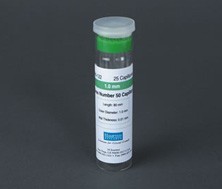Hampton MembFac • Crystal Screen Lite • MembFac HT
Primary sparse matrix crystallization screen for membrane proteins and samples with limited solubility 膜蛋白和样品溶解度有限样品
 Membrane protein sparse matrix screens
Membrane protein sparse matrix screens
 Sparse matrix formula efficiently samples salts, polymers, organics and pH
Sparse matrix formula efficiently samples salts, polymers, organics and pH
 pH range 4.6 – 8.5
pH range 4.6 – 8.5
 Formulated for use with detergents
Formulated for use with detergents
 Tube or Deep Well block format
Tube or Deep Well block format
 Crystal Screen Lite features a lower ionic strength than the original Crystal Screen
Crystal Screen Lite features a lower ionic strength than the original Crystal Screen
MembFac is a highly effective sparse matrix screen specifically designed as a preliminary screen for the crystallization of membrane proteins. MembFac is based upon the highly effective biased sparse matrix methodology. The MembFac screen matrix is optimized for the crystallization of membrane proteins.
MembFac contains 48 unique reagent formulations. With this set of 48 conditions, numerous chemicals and chemical combinations are utilized, allowing one to evaluate a large variety of potential crystallization conditions. MembFac covers a broad pH range between 4 and 9.
The Rationale
The basic rationale of MembFac is to perform a sparse matrix screen while changing the detergent dimension because detergents play an important factor in the crystallization of membrane proteins. A MembFac screen is to be completed for each detergent. Detergent screens are available separately.
The Method
The membrane protein of interest is first isolated in the detergent which gives the highest stability and activity. The protein concentration should be approximately 10 to 20 mg/ml and the detergent concentration should be only slightly above the CMC. The sample is then set against MembFac, using all 48 solutions plus the screening detergent(s) of choice. The screening detergent concentration should be approximately one to three times the CMC. Hence, for each detergent screened, one would utilize approximately 1 to 2 mg of sample.
The MembFac protocol was used to crystallize membrane proteins including SQR, fumerate: quinone oxireductase, LHII, and LHCII.
Crystal Screen Lite is a sparse matrix of trial crystallization reagent conditions based upon the Crystal Screen™.3 The primary screen variables are salt, pH, and precipitant (salts, polymers, volatile organics, and non-volatile organics).2Crystal Screen Lite differs from the original Crystal Screen kit in that the primary precipitant reagents are one-half the concentration of that used in the original Crystal Screen formulation. The secondary salts, ions, and buffers remain at the original Crystal Screen concentration. Reducing the primary concentration of the primary precipitant results in a screen which is “more gentle” on the sample and typically produces much less precipitate conditions than the original Crystal Screen.
MembFac contains 48 unique reagents, 10 ml each.
MembFac HT contains 1 ml each of all 48 reagents from MembFac and reagents 1-48 from Crystal Screen Lite in a single Deep Well block format.
Ready-to-use reagents are sterile filtered and formulated with ultra-pure Type 1 water, using the highest purity salts, polymers, organics and buffers. Individual reagents are available through the Hampton Research Custom Shop.
| CAT NO |
NAME |
DESCRIPTION |
| HR2-114 |
MembFac |
10 ml, tube format |
| HR2-128 |
Crystal Screen Lite |
10 ml, tube format |
| HR2-137 |
MembFac HT |
1 ml, Deep Well block format |












